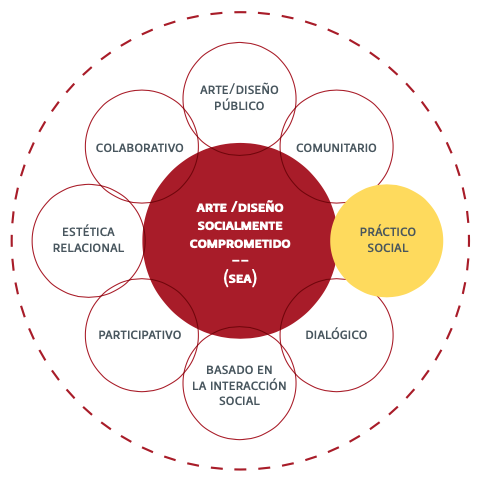Transpedagogy and Activist Design
Main Article Content
Abstract
The purpose of this article is to offer some reflections derived from professional experience in the field of design and activist practices. A first hypothesis is that many of the socially committed design projects are genuinely pedagogical, because they combine educational processes and creation, bringing a different experience to formal design education.
Article Details
References
Alinsky, S. (2012), Tratado para radicales: manual para revolucionarios pragmáticos. Madrid: Traficantes de Sueños.
Beuys, J. and C. Bodenmann-Ritter (1995), “Joseph Beuys. Cada hombre, un artista: conversaciones”, Documenta 5-1972. Madrid: Editorial Visor.
Curle, A. (1973), Education for Liberation. New York: Wiley. Edwards, B. (2000), Nuevo aprender a dibujar con el lado derecho del cerebro. Barcelona: Ediciones Urano.
Eisner, E. (1995), Educar la visión artística. Barcelona: Ediciones Paidos.
Flood, M., B. Martin, and T. Dreher (2013), “Combining Academia and Activism. Common Obstacles and Useful Tools”, Australian Universities’ Review 55, no. 1: 17-26.
Freire, J. (2009), “Educación expandida y nuevas instituciones: ¿Es posible la transformación?”, Educación Expandida, 67-84. Sevilla: Zemos98.
Fuad-Luke, A. (2009), Design Activism: Beautiful Strangeness for a Sustainable world. Sterling: Earthscan.
Gardner, H. (1994), Educación artística y desarrollo humano. Barcelona: Ediciones Paidós.
Hadberg, A. V. (2006), “The Methodology of Paul Willis. A Review of ‘Learning to Labor: How Working Class Kids Get Working Class Jobs’”, Athenea Digital: Revista de pensamiento e investigación social no. 9. Consultado 16 febrero, 2014. http://antalya.uab.es/athenea/num9/ hadberg.pdf.
Helguera, P. (2011), Education for Socially Engaged Art. A Materials and Techniques Handbook. New York: Jorge Pinto Books.
Helguera, P. (2011), Pedagogía en el campo expandido. 8ª Bienaldo Mercosul. Ensayos de Geopoética. Porto Alegre: Fundação Bienal do Mercosul.
Helguera, P. (2010), “Notes Towards a Transpedagogy”, Art, Architecture, Pedagogy: Experiments in Learning, edited by K. Ehrlich, 98-112. Valencia, California: Center for Integrated Media.
Hernández Zamora, F. (2014), “Concepto ampliado de arte”, consultada 9 mayo, 2014. http://plasticasocial.blogspot.com.es/p/concepto-ampliado-de-arte.html.
Illich, I. (1985), La sociedad desescolarizada. México: Joaquín Mortiz-Planeta.
Krauss, R. (1979), “Sculpture in the Expanded Field”, October 8, no. Spring: 30-44.
Lamarhe-Vadel, B. (1994), Joseph Beuys. Madrid: Ediciones Siruela.
Le Quernec, A. (2000), Made by Children. Quimper: Imprimerie du Commerce.
Le Quernec, A. (2005), Alain Le Quernec. Beijing: Lingnan Art Publishing House.
Maturana, H. R. and F. J. Varela (1980), Autopoiesis and Cognition: The Realization of The Living. Dordrecht, Holland; Boston: D. Reidel Pub. Co.
McIntyre, A. (2008), Participatory Action Research. Thousand Oaks: Sage Publications.
Read, H. (1982), Educación por el arte. Barcelona: Ediciones Paidós.
Ruiz-Mejía, J. (2007), “El arte en la educación, según Herbert Read”, Revista Aleph. Consultado 17 marzo, 2014. http:// www.revistaaleph.com.co/component/k2/item/127-elarte- en-la-educacion-segun-herbert-read.html.
Smith, S. E., Willms, D. G., and Johnson, N. A. (1997), Nurtured by Knowledge: Learning to do Participatory Action-Research. New York: Apex.
Soar, M. A. (2002), Graphic Design/Graphic Dissent: Towards a Cultural Economy of an Insular Profession. PhD thesis, University of Massachusetts at Amherst.
Thompson, E. P. (2014), La economía moral de la multitud y otros ensayos. Bogotá: Clásicos Historia Crítica.
Verlee Williams, L. (1995), Aprender con todo el cerebro. Barcelona: Ediciones Roca.


